|
Neck and Head Pain is
the most common expression of myofascial dysfunction yet chronic headache
sufferers respond badly to diagnoses of muscle tension headache. The labels of
"vascular" headache or "neurological disease" seem more respectable, more
likely to be taken seriously. But "vascular" doesn't stop at the head;
"neurological" isn't restricted to the brain or spine. Tight muscles and fascia
press, shear, block, and strangle both blood vessels and nerves throughout the
body. “Muscle tension headache” can mean very simply “headache due to tight
muscles” but from there it has been a short trip to “You’re just tense” and . .
. “Have you considered psychiatric counseling?” with the clear implication
that...
The pain is not real. YOU are just crazy.
Many pains do indeed have psychiatric components, but the
psychogenic diagnosis is woefully overdone. Strangely, it is rarely applied to
knee pain, big toe pain, or shoulder pain, but is used all too often by the
physician, who, when asked for the underlying cause of head pain, cannot bring
himself to say “I don’t know.” And there's a lot to know. Over 20 muscles
(primarily of the neck) refer pain to the head. Several refer pain
specifically to the eye. At least three refer pain directly to the teeth for
reasons that will never be relieved by fillings or repeated root canals.
Of particular concern is strain or compression of the trigeminal nerve
and its branches which mediate tissue inflammation, vasodilation and vascular
permeability -- all issues in migraine. Over the last few years, plastic
surgeons have verified the muscle-migraine connection beginning with the odd
observation that Botox injections in the frontalis and corrugator muscles of the
brow also eliminated migraines. If irritated muscles and nerves fire off
an inflammatory response and vasodilation, is the resulting headache "muscular,"
"neurological," or "vascular"? Perhaps the only real answer is "all of the
above" because amazingly enough, it all functions together -- or dysfunctions
together. For patient or physician, the following pain patterns may look
surprisingly familiar and will, we hope, point the user in the direction of
truly effective treatment. In the following illustrations, black dots
indicate common trigger point locations; red areas indicate the pain referred by
the trigger point. You can evaluate these muscles with the Cervical and Masticatory Tests excerpted and
adapted from our Range-of-Motion Testing
Charts.
- Upper Trapezius > Tension headache and "bursitis". The
trapezius muscle of the back and neck is the single muscle most likely to have
trigger points in both adults and children.
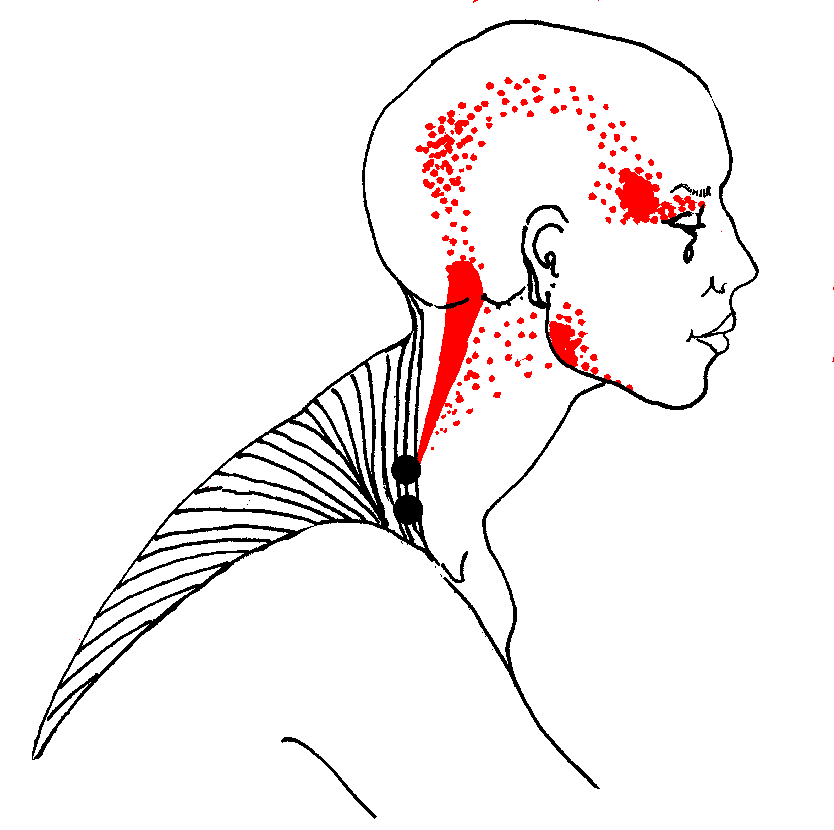 The upper trapezius refers a "fish-hook" pain pattern up the back side of the
neck to the head, and around the temple to the eye. There may be goosebumps to
upper arm and thigh possibly with nausea and visual disturbances. Problems often
begin with heavy bags or purses, balancing phones between head and shoulder, or
imbalances and strain by tight SCM or scalene muscles.
The upper trapezius refers a "fish-hook" pain pattern up the back side of the
neck to the head, and around the temple to the eye. There may be goosebumps to
upper arm and thigh possibly with nausea and visual disturbances. Problems often
begin with heavy bags or purses, balancing phones between head and shoulder, or
imbalances and strain by tight SCM or scalene muscles.
The nauseating pain of a one-sided trapezius headache is commonly diagnosed
as "migraine" although migraine medications often fail to relieve the
pain. ("Bursitis" and backpain may arise from the upper and lower fibers of the
same muscle; see Introduction to Shoulder
Pain.)
- Sternocleidomastoid (SCM) >
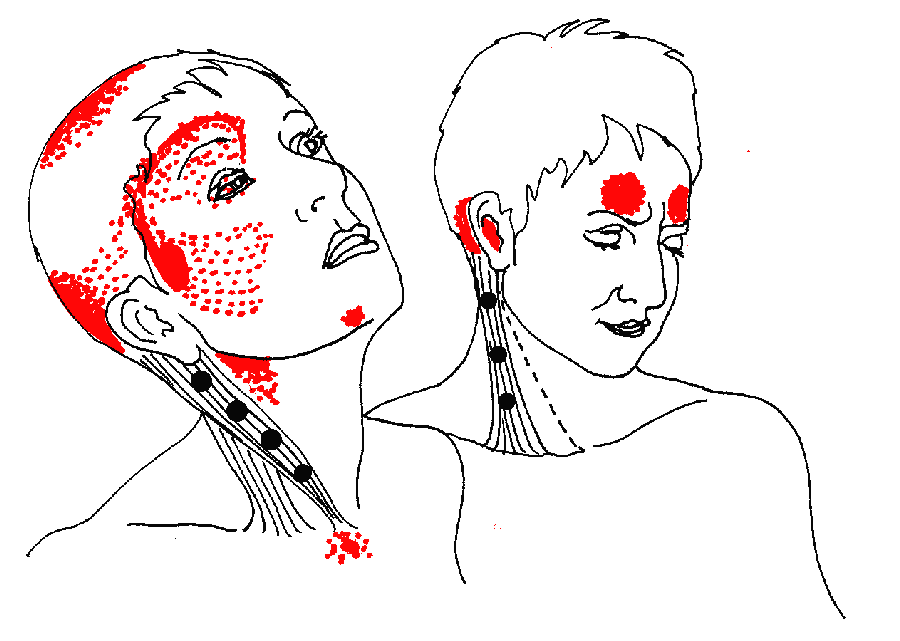 Dizziness, nausea, "migraine" and "sinus". Because of its intimate
involvement with brain stem and the vagus nerve, the SCM muscle of the
neck produces a long list of neurological and pain symptoms which
appear primarily in the head and face but which may also appear
as nausea, motion sickness, and balance problems.
These are commonly mistaken for migraine, sinus headache, inner-ear problems,
trigeminal neuralgia -- and so on. SCM has one of the most extensive patterns of
pain and dysfunction, yet is one of the easiest muscles to self-treat. Click
the link to see an info page on this muscle.
Dizziness, nausea, "migraine" and "sinus". Because of its intimate
involvement with brain stem and the vagus nerve, the SCM muscle of the
neck produces a long list of neurological and pain symptoms which
appear primarily in the head and face but which may also appear
as nausea, motion sickness, and balance problems.
These are commonly mistaken for migraine, sinus headache, inner-ear problems,
trigeminal neuralgia -- and so on. SCM has one of the most extensive patterns of
pain and dysfunction, yet is one of the easiest muscles to self-treat. Click
the link to see an info page on this muscle.
-
Scalenes > "Thoracic outlet" and "carpal tunnel" syndromes;
chest, arm, and upper back pain. Scalenes contribute to severe tension
headache and are one of the leading causes of "carpal tunnel syndrome." On the
list of a half-dozen possible causes, the carpal tunnel itself is dead
last. This is one of the reasons why carpal tunnel surgery is so
ineffective. Check before you cut!
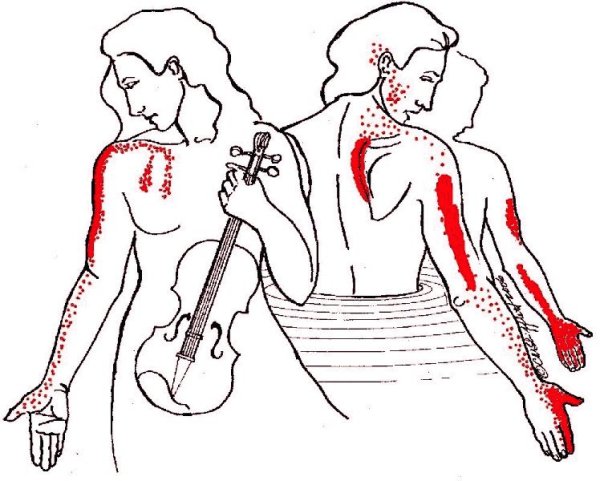
Notice also the fingerlike projections of pain extending down the chest. This
is easily confused with angina. If you think you are having heart problems, get
to a doctor immediately!
If, however, no cardiac problems are found, consider other muscles,
especially if the chest pain was accompanied by a tingly thumb or index finger.
Scalene pain typically extends down the upper arm, skipping the elbow. There may
also be severe pain at the vertebral border of the scapula.
All of these patterns may be painfully familiar to wrestlers and Aikidoists
who have suffered too many "neck-a-nage's." In Aikido, students who don't
understand kokyu-nage techniques (based on balance and timing) tend to
interpret what they think they see as: "Swing your partner around by the
neck then drop him on his head," a painful variation on the game of “Hangman.”
In professional football, doing the same thing to a large, padded, extremely
fit refrigerator-sized opponent by grabbing his face-guard will get you an
instant 15-yard penalty, for very good reason.
The consequences of “neck-a-nage” can be extremely painful or disabling. The
the electrical supply for arm and fingers comes from the brachial plexus, the
“wiring harness” originating in the neck. If the source of finger pain is
diagnosed as entrapment of the median nerve, the patient may be referred for
carpal tunnel surgery. If the problem is identified as scalene entrapment of the
brachial plexus, the current treatment is surgical removal
("scalenectomy") of the anterior scalene and the first rib to which the muscle
is attached. Unfortunately, this barbaric surgery usually causes more problems
than it cures. Where care, consideration, and technical skill on the mat have
failed, know this pain pattern and how to treat it -- by treating the muscle and
its trigger points.
- Masseter > TMJ, tinnitus, "sinus", and toothache. For its
size and weight, the masseter is the strongest muscle in the body and its
effects are not trivial.
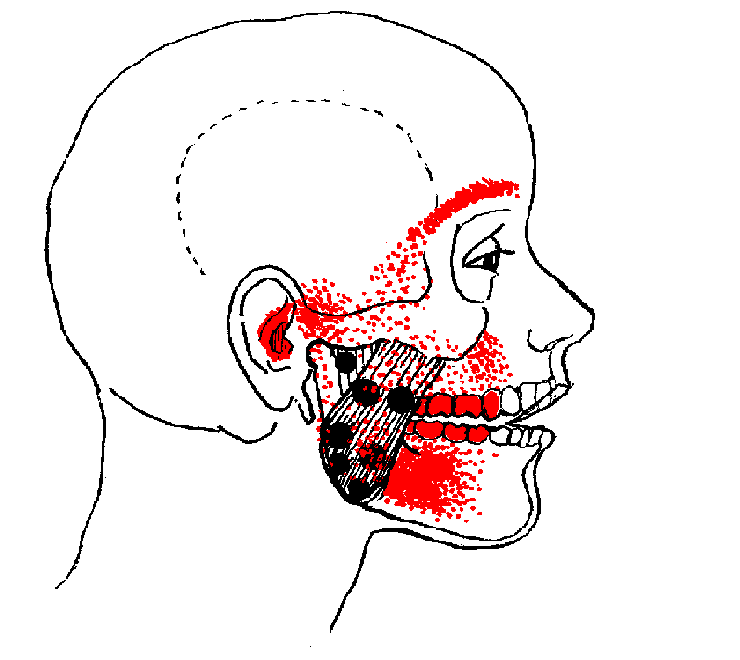 It refers pain
to both upper and lower molar teeth, causes TMJ dysfunction, earache and a
"sinus" pain over the eyebrow.
Prozac and related anti-depressants such as Paxil specifically cause
tightness in this muscle. If you're grinding your teeth at night and waking with
a headache, ask your doctor about taking the medication during the daytime when
you can be more aware of clenching and tooth-grinding which tense the masseter
but also strain the temporalis . . . It refers pain
to both upper and lower molar teeth, causes TMJ dysfunction, earache and a
"sinus" pain over the eyebrow.
Prozac and related anti-depressants such as Paxil specifically cause
tightness in this muscle. If you're grinding your teeth at night and waking with
a headache, ask your doctor about taking the medication during the daytime when
you can be more aware of clenching and tooth-grinding which tense the masseter
but also strain the temporalis . . .
- Temporalis > "Tension / sinus" headache, TMJ and toothache in
upper teeth.
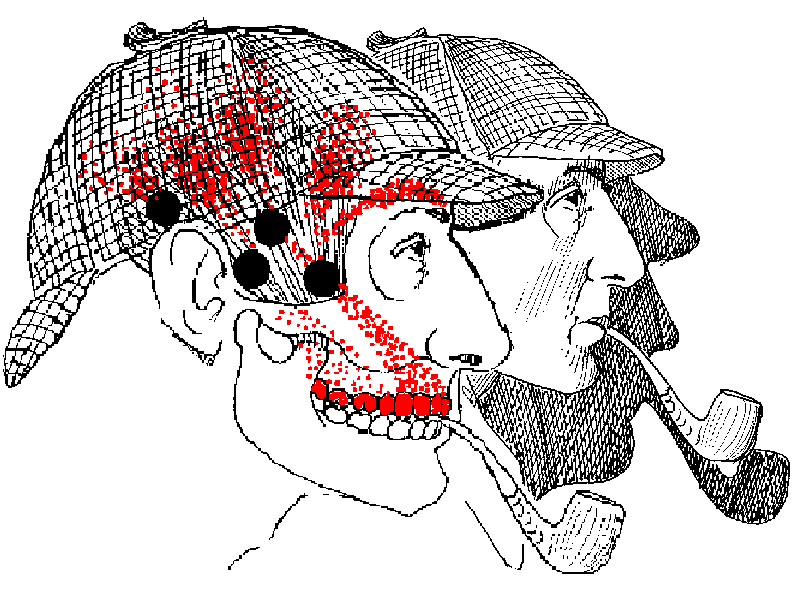 Combine a
head-forward position with a pipe and long hours of playing the violin (see the
scalene pain pattern, above) and what do you get?
"Elementary!" cries Dr. Watson. "Head pain, tooth pain, and extreme tooth
sensitivity to heat/cold and vibration." Combine a
head-forward position with a pipe and long hours of playing the violin (see the
scalene pain pattern, above) and what do you get?
"Elementary!" cries Dr. Watson. "Head pain, tooth pain, and extreme tooth
sensitivity to heat/cold and vibration."
You may wisely eschew "The Seven Percent Solution" in favor of directions to
massage the temples to relieve tension headaches. But to make it more effective,
notice the location of the trigger points and their specific areas of pain.
Temporalis is remarkable for spoke-like lines of pain up into the temple and
down into the upper teeth. Follow these lines and you will feel distinct taut
bands. Massaging them may provide temporary relief. But the best approach is to
follow the taut bands down to their trigger points located as shown near the
cheekbones and adjacent to the ears.
- Pterygoids > TMJ and "sinus" pain. The lateral pterygoids
(at right) help to open and protrude the jaw. These relatively weak muscles are
easily strained in opposing the powerful masseter and temporalis muscles that
close the jaw.
The pterygoids commonly develop trigger points which in turn
cause pain and/or clicking in the TMJ joint. They may block drainage from the
maxillary sinus causing more still more pain. They are also linked to tinnitis,
and cause lateral deviation on opening the jaw. There may be entrapment of the
buccal nerve causing numbness / tingling in the cheek (see buccinator, below).
The masseter muscle and medial pterygoid support the jaw like a sling. Masseter
is on the outside, medial pterygoid inside; together they close the jaw. 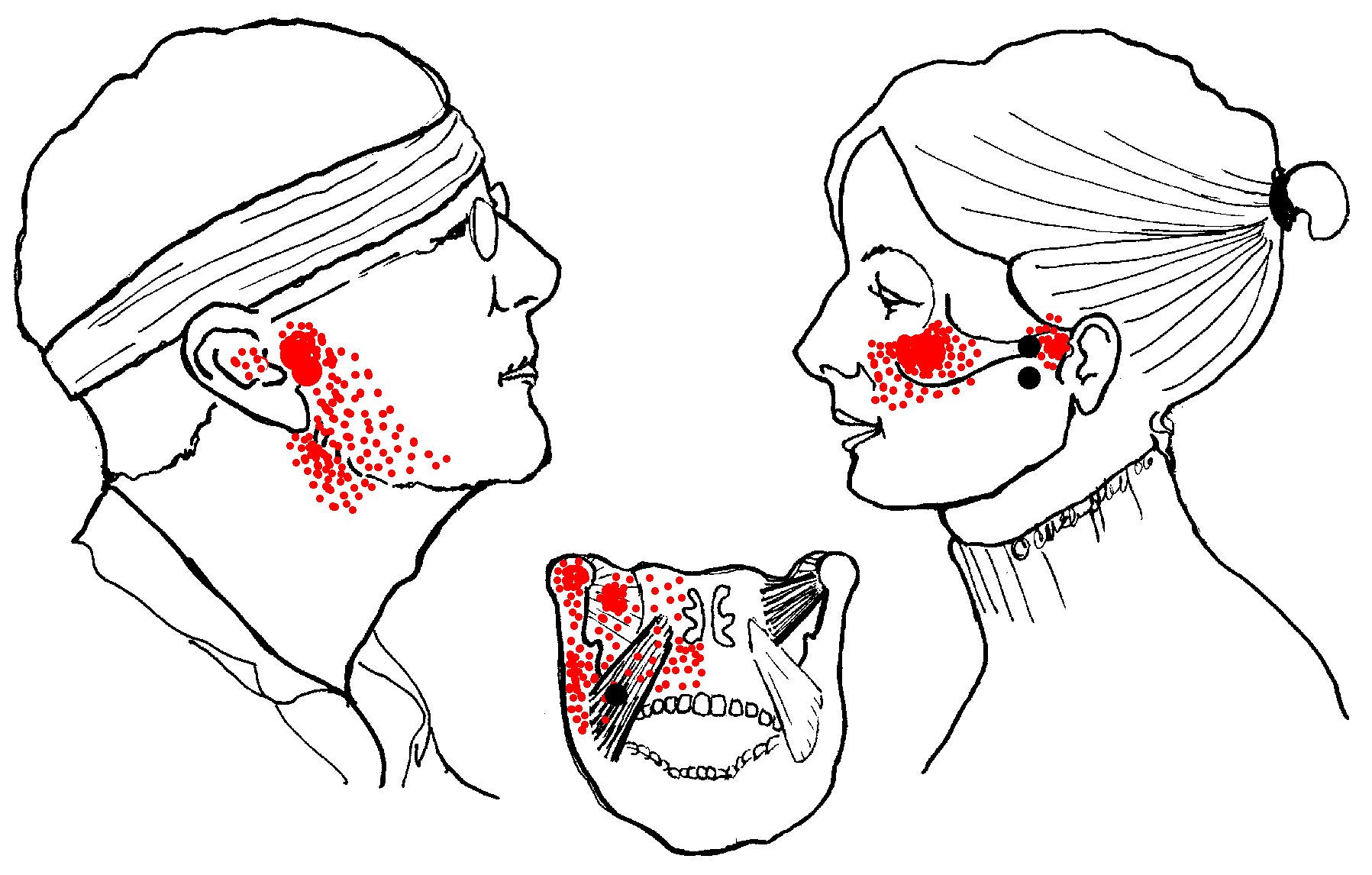 Medial pterygoids produce diffuse pain in the mouth involving the floor of
the nose, tongue, throat and hard palate; pain below and behind the TMJ joint,
pain and/or stuffiness of the ear, difficulty swallowing, lateral deviation and
possibly pain on opening the jaw. They can also entrap the lingual nerve
producing the odd symptom of a bitter, metallic taste in the mouth (which the
patient may not connect with other symptoms and may not report for fear
of being thought "crazy.")
Medial pterygoids produce diffuse pain in the mouth involving the floor of
the nose, tongue, throat and hard palate; pain below and behind the TMJ joint,
pain and/or stuffiness of the ear, difficulty swallowing, lateral deviation and
possibly pain on opening the jaw. They can also entrap the lingual nerve
producing the odd symptom of a bitter, metallic taste in the mouth (which the
patient may not connect with other symptoms and may not report for fear
of being thought "crazy.")
- Buccinator > Cheek pain. This muscle forms the wall of
cheek and mouth. It's
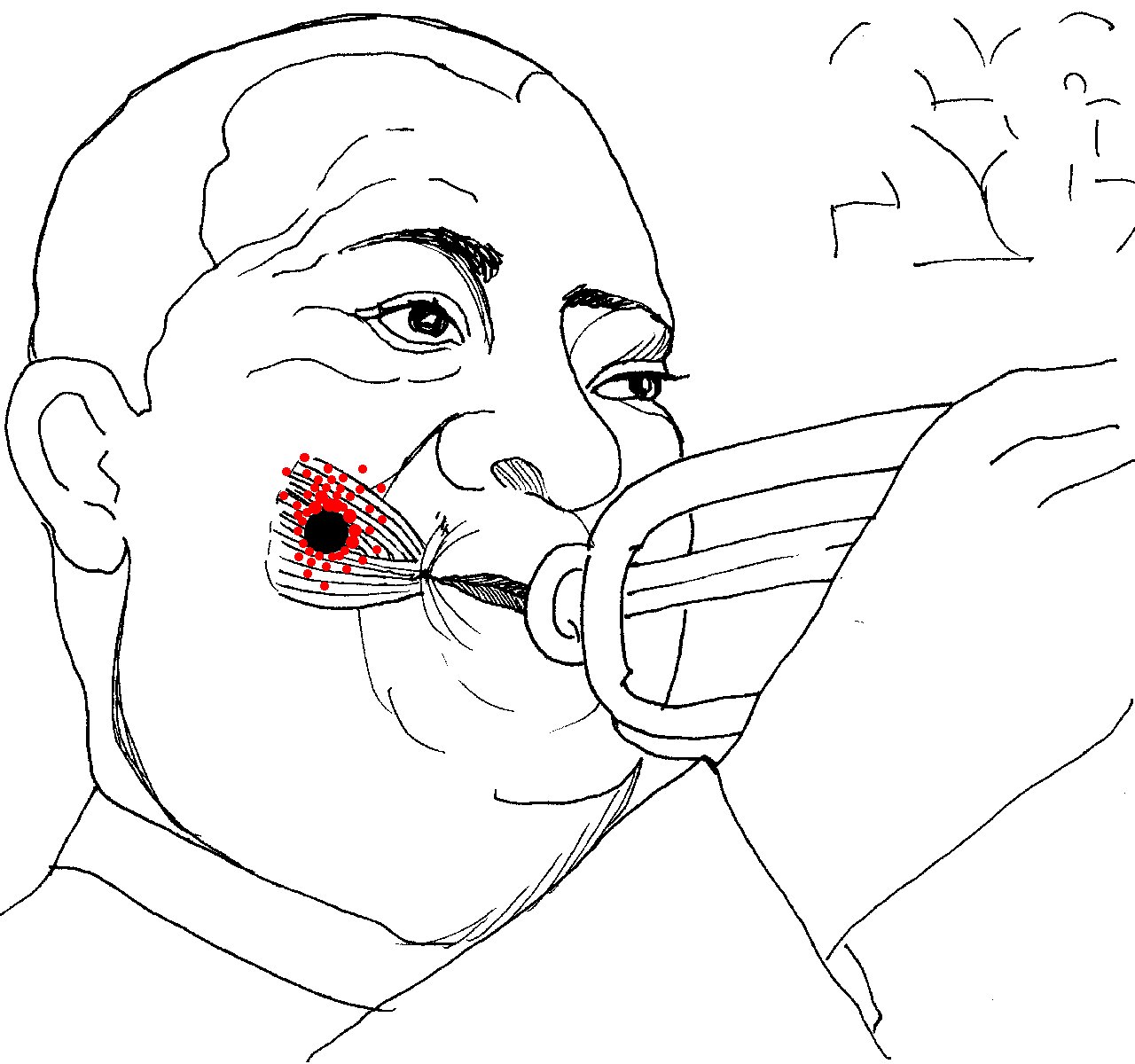 the part of the cheek
that puffs out when playing the trumpet (for which it is named), blowing up
balloons or stuffing one's mouth too full. Buccinator pain may appear suddenly
following dental/orthotic work.
There are no entrapments by the buccinator itself, but the lateral pterygoid
can entrap the buccal nerve which supplies the skin and mucous membrane in this
area. The muscle itself can cause local pain deep in the cheek while chewing,
commonly misdiagnosed as TMJ dysfunction. the part of the cheek
that puffs out when playing the trumpet (for which it is named), blowing up
balloons or stuffing one's mouth too full. Buccinator pain may appear suddenly
following dental/orthotic work.
There are no entrapments by the buccinator itself, but the lateral pterygoid
can entrap the buccal nerve which supplies the skin and mucous membrane in this
area. The muscle itself can cause local pain deep in the cheek while chewing,
commonly misdiagnosed as TMJ dysfunction.
- Digastric > Neck pain and and toothache in the lower
incisors. The digastric assists the lateral pterygoid in opening the jaw
against the counterforce of the far more powerful temporalis and masseter
muscles. The upper portion can entrap the external carotid artery and auricular
artery decreasing blood flow to the brain.
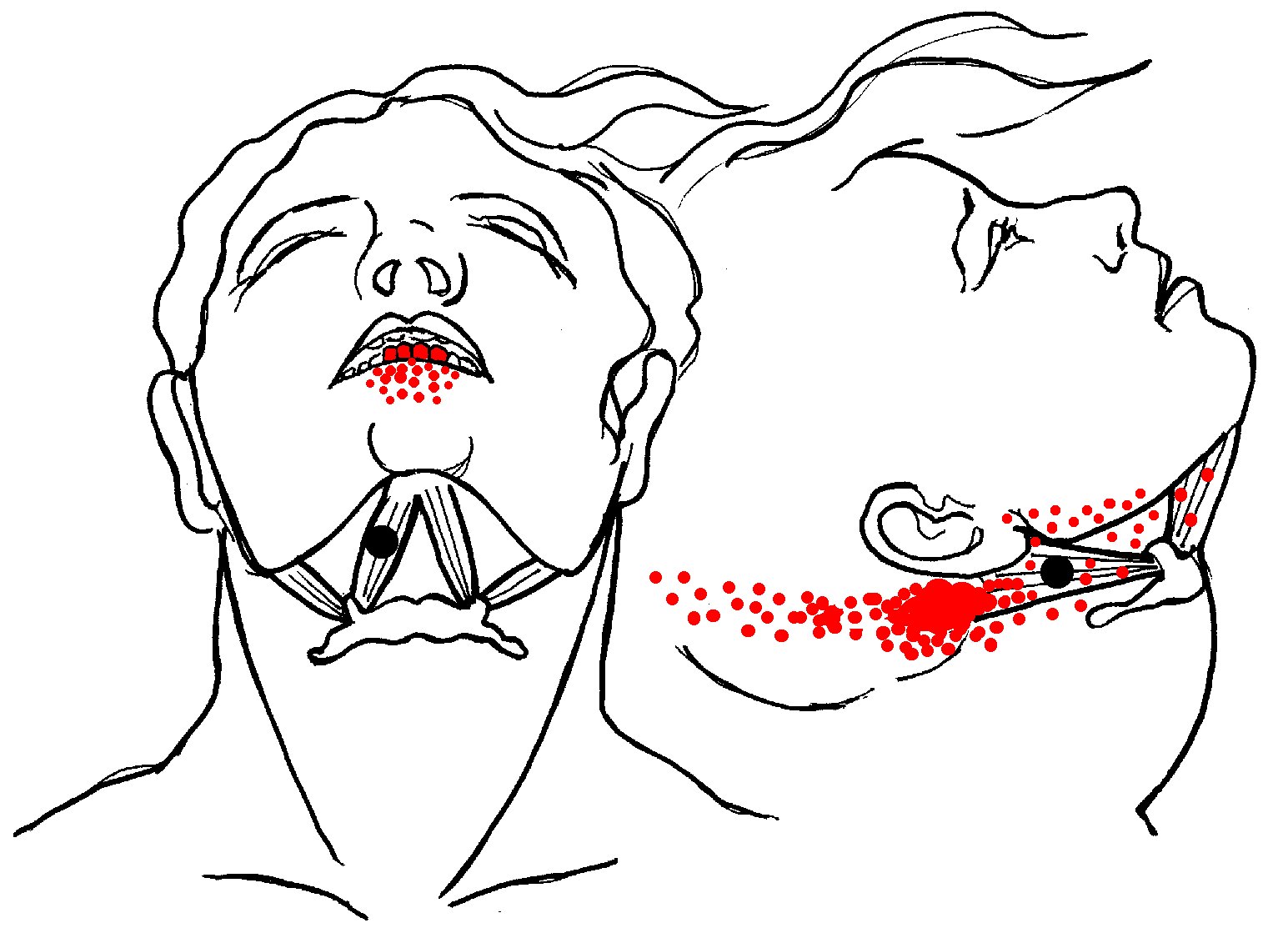 Strained by
retrusion of the jaw (as in playing the clarinet or similar wind instruments) or
by holding a violin in place with the chin. Commonly damaged in whiplash
injuries in concert with other neck muscles such as trapezius and splenius.
Trigger points in the anterior belly send pain to the four lower incisor
teeth and the alveolar ridge. There may also be pain in the throat and tongue
and difficulty swallowing because of the relationship to the hyoid bone. Strained by
retrusion of the jaw (as in playing the clarinet or similar wind instruments) or
by holding a violin in place with the chin. Commonly damaged in whiplash
injuries in concert with other neck muscles such as trapezius and splenius.
Trigger points in the anterior belly send pain to the four lower incisor
teeth and the alveolar ridge. There may also be pain in the throat and tongue
and difficulty swallowing because of the relationship to the hyoid bone.
Trigger points in the posterior belly refer pain to the upper
sternocleidomastoid muscle, pain to the throat possibly as far back as the
occiput. There may also be difficulty swallowing and a bothersome feeling of a
persistant "lump" in the throat. That "lump" may be the hyoid bone which, again,
is not moving properly.
- Orbicularis > Nose and cheek pain (shown with zygomaticus,
below). A trigger point in orbicularis refers pain along the eybrow,
alongside the nose to the upper lip. There may be visual disturbances and
problems with "jumpy print" in reading, along with droopy eyelid (ptosis).
- Zygomaticus > Nose, cheek, and forehead pain (shown with
orbicularis, below).
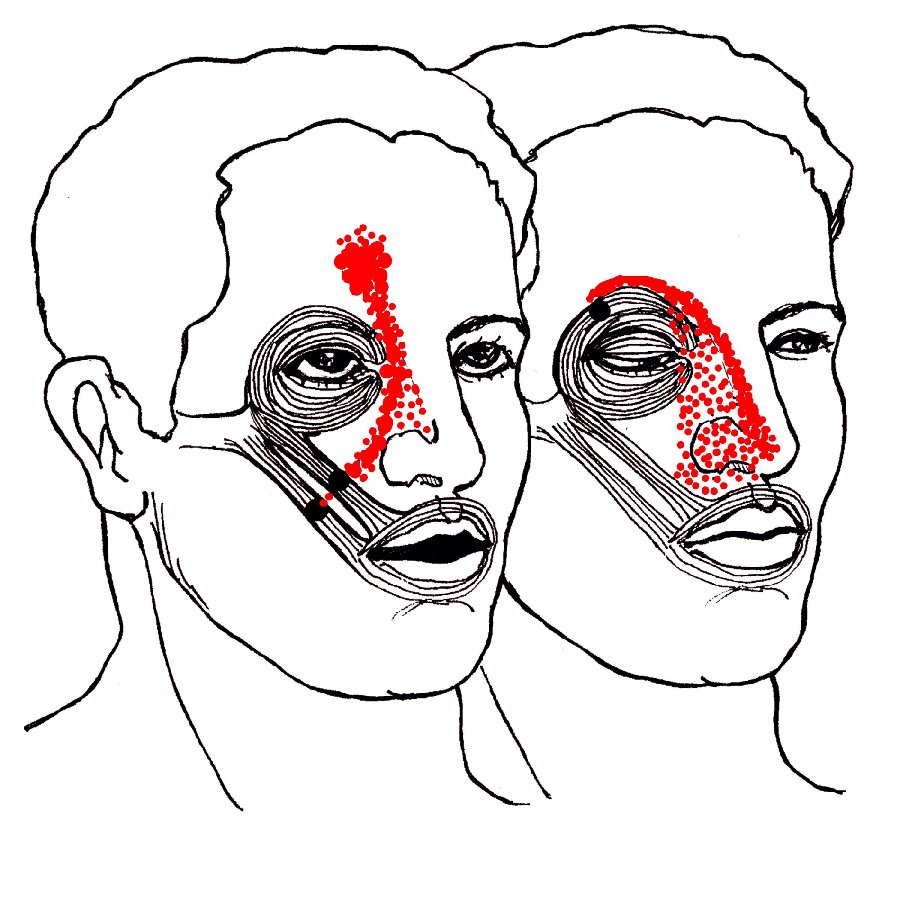
Orbicularis and zygomaticus are the only two muscles that refer pain to the
nose. Both patterns are commonly mistaken for "sinus" pain but may be due to a
blow to the eye or simply smiling too long at the reception.
Zygomaticus can entrap blood vessels that travel from cheek to nose and up to
the forehead. The resulting pain is not "sinus," it's a muscle cramp due to
reduced blood and oxygen supply -- but no less painful.
- Occipitofrontalis > Temporal and eye pain.
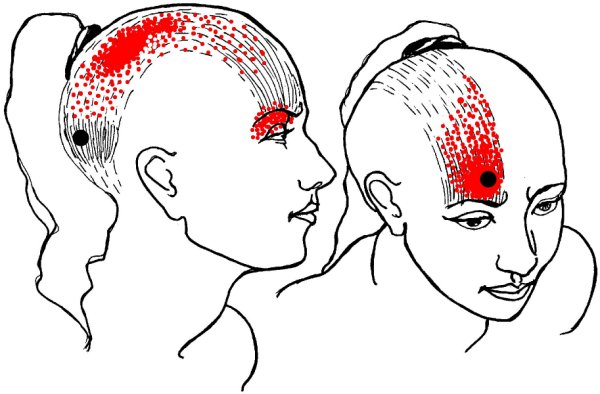
Trauma to the scalp fascia or the occipitalis at the back of the skull can
transmit pain through the head and into the eye. Trauma may include a
blow to the back of the head, strain from a tight ponytail or bun, or the weight
of long, heavy hair.
In one case I know of, a man struck the top of his head on the corner of a
cabinet. Result: a slight puncture wound in the scalp, a brutal pain in the
eye.
Frontalis helps open the eyes, raises the eyebrows, and wrinkles the forehead
into "worry lines." It is commonly used by biofeedback practitioners to monitor
muscle tension. Trauma to frontalis (whether a blow to the forehead or habitual
frowning) can cause severe frontal headache often diagnosed as "migraine."
Frontalis is one of the muscles that definitively proved the muscle-migraine
connection.
Botox injections paralyzed the frontalis, eliminating "worry lines" but they
also had the surprising side effect of halting chronic "migraines". Or maybe not
so surprising, as frontalis entraps the supraorbital nerve. The related
corrugator supercilii (at the top of the nose between the eyebrows) compresses
branches of the supraorbital nerve along with the supratrochlear nerve and
branches of the supraorbital nerve. All of these are branches of the trigeminal
nerve which is heavily involved in migraine. You can treat trigger points with
great results -- or, avoid compressing those muscles. Your frown may be giving
you a headache!
- Splenius Capitis > Occipital neuralgia and "word processor
headache". Splenius capitis and splenius cervicis (below) are almost
always injured in auto accidents, regardless of the direction of the
blow. They are commonly injured in "head rolling" movements in exercise classes,
always strained by head forward position and by computer use or other reasons
for sitting with head held forward and turned to the side. Splenius capitis
(shown below, right) typically causes a pain at the top lateral side of head.
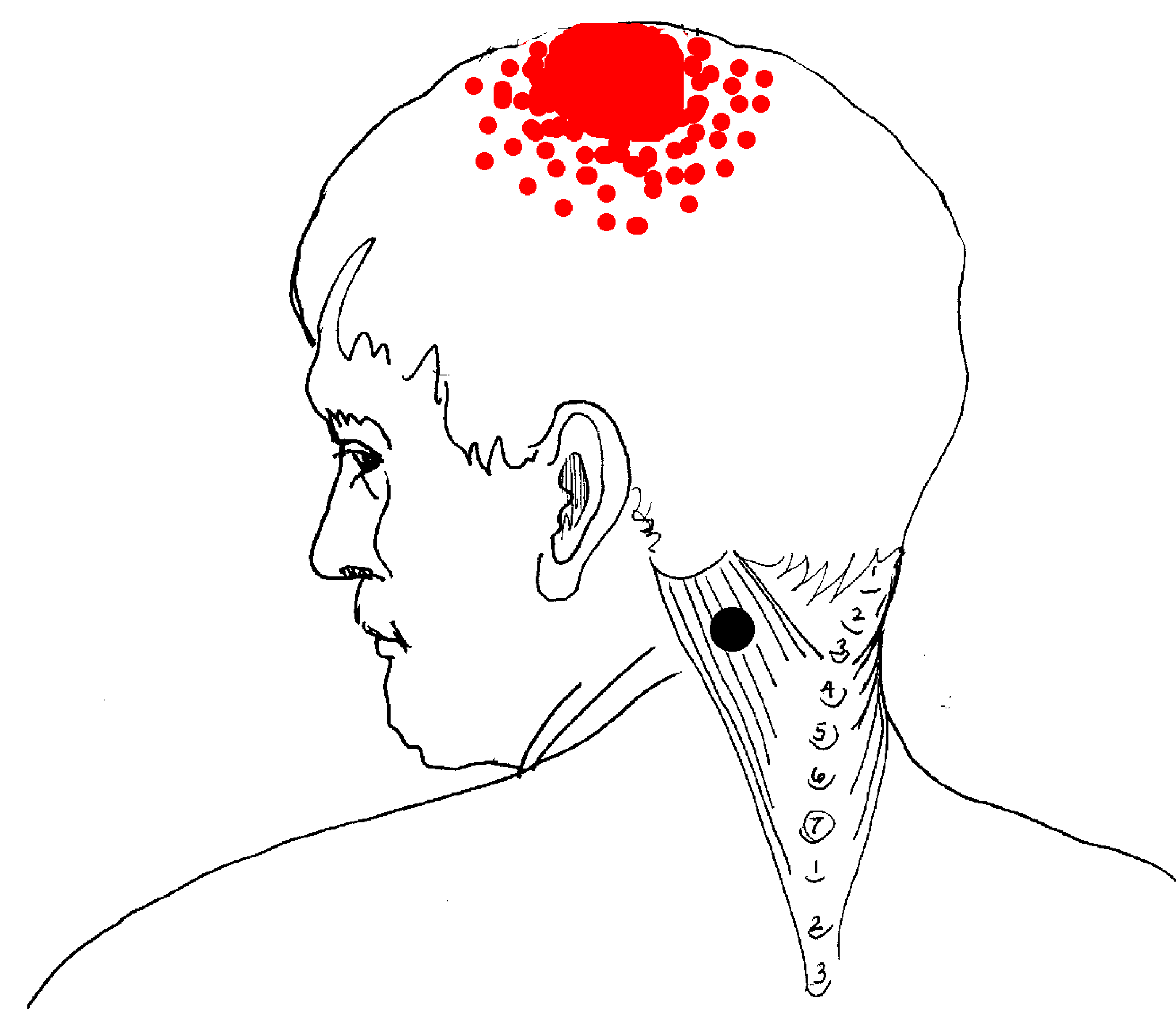
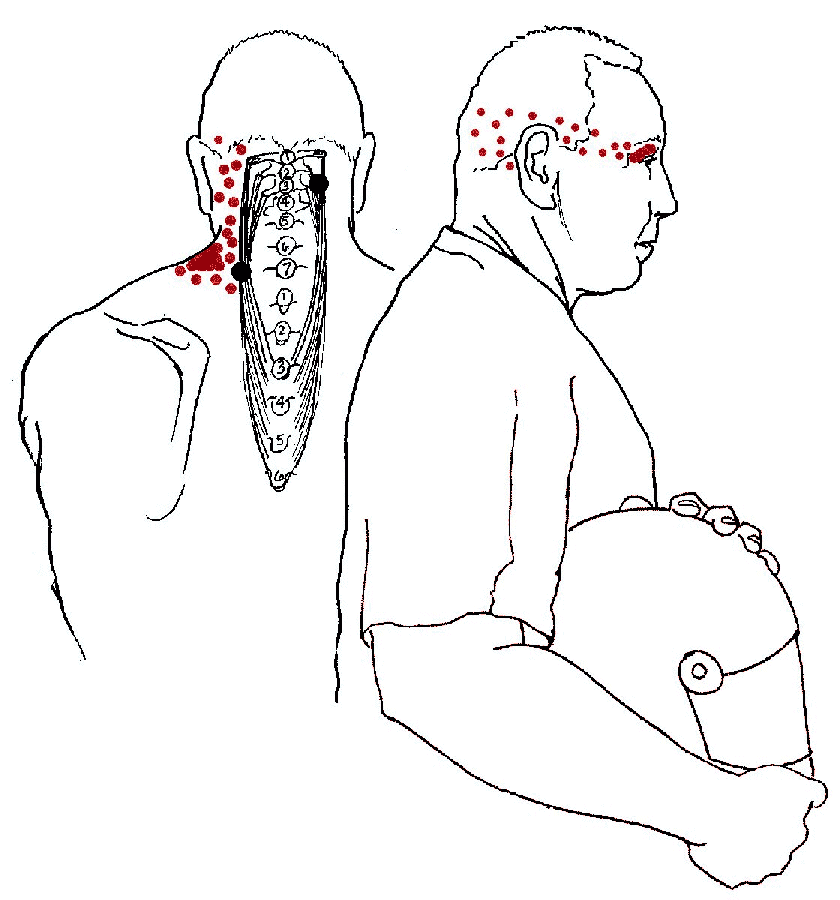
- Splenius Cervicis > Neck pain, eye pain, and blurred
vision. Splenius cervicis (above, left) is strained in all the ways as
splenius capitis (above, right) but the results are even more brutal. A trigger
point high in the neck portion of the muscle sends pain through the head
from the occiput and into the eye. Even without the pain, there may be blurred
vision. The lower trigger point refers pain to the angle of the neck. Reading
under a drafty air conditioner or riding a motorcycle with head forward with a
cold wind whipping around the edge of the helmet is damaging to these muscles.
- Semispinalis Capitis > Head pain and occipital neuralgia.
Injured in whiplash and involved in "tension" and "cervicogenic" headache.
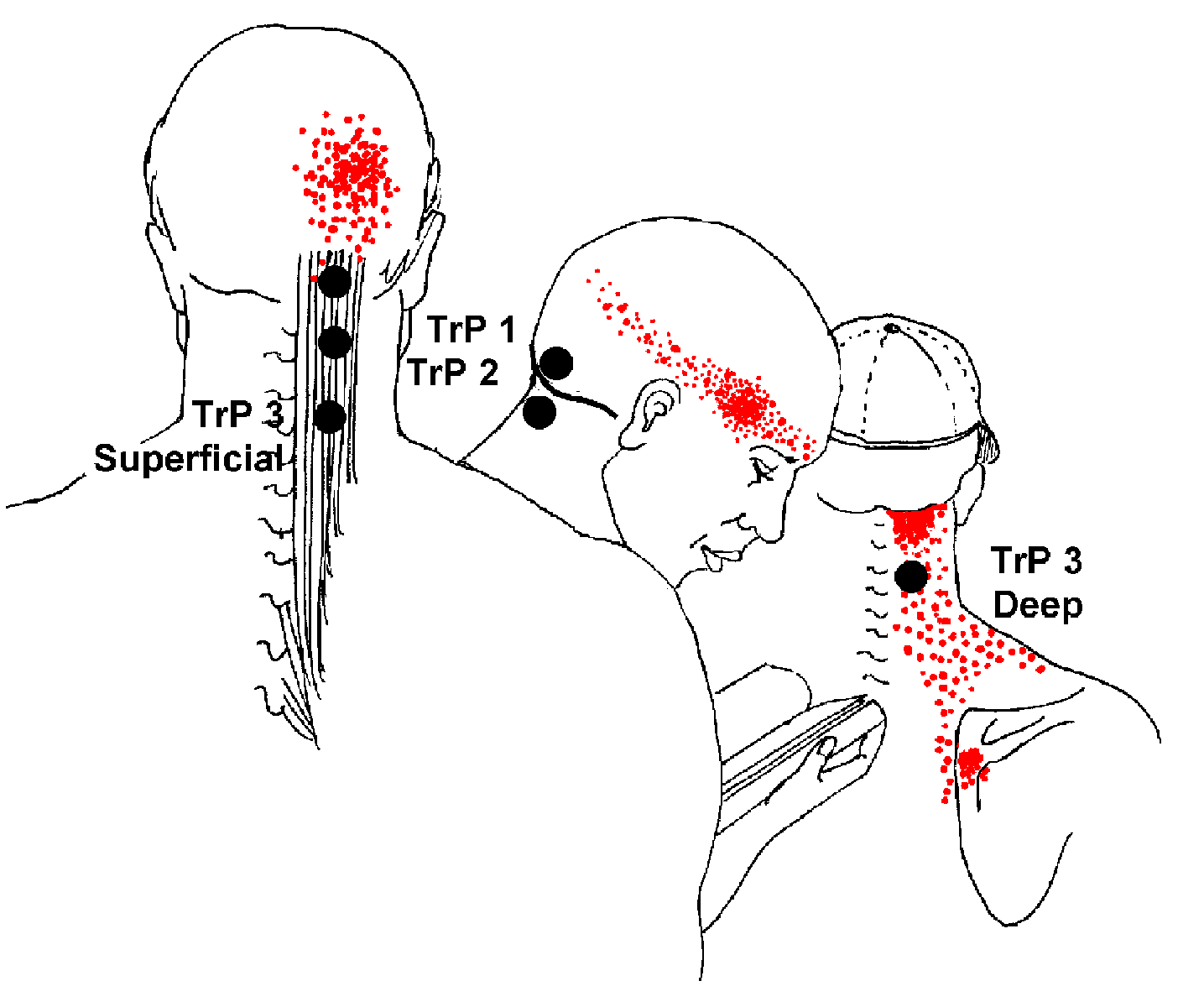
Semispinalis capitis is commonly injured in auto accidents. You can injure it
more slowly but just as effectively with a chronic head-forward position.
When tight, semispinalis may entrap the greater occipital nerve which in turn
causes numbness, tingling and/or burning pain extending over the back of the
head to the top (vertex) of the head. It may be difficult to touch chin to
chest, and sufferers may be unable to bear the pain of laying the back of the
head on a pillow.
Relieve nerve pain with cold.
Relieve muscle pain with
moist heat.
In either case, look for the origin of the pain, rarely
the spot where it hurts.
- Semispinalis Cervicis > Even more head pain.
This
muscle typically produces a vague band of pain from occiput along side of head
to just behind orbit (similar to suboccipital pain pattern).
- Longus Capitis, Longus Colli > Neck, ear, and eye pain. A
pain in the neck, and surprisingly, pain in the eye and ear and possibly the
forehead (more "sinus" pain!) as well. Almost always injured in whiplash.
- Multifidi and Rotatores > Basal skull pain, neck pain and
scapular pain.
This pain arises from the tiny muscles that run between
the individual vertebrae of the spine.
- Levator scapula > The "wry" or "stiff neck" muscle.
This muscle is the Number One cause of "stiff" or "wry" neck and the second
most common shoulder girdle muscle (trapezius is Number One) to have trigger
points. Working with trapezius, levator shrugs the shoulders and helps prevent
forward flexion of the neck, hence it is also damaged in whiplash injuries. In
daily life, it is commonly strained when shoulder (or shoulders) are chronically
hunched, either in stress, or by attempting to keep a strap from sliding off the
shoulder, especially when the muscle is cold or fatigued. Pain in the angle of
the neck and along the vertebral border of the scapula may be so severe that
patient cannot move the neck at all.
- Suboccipitals > Temporal and eye pain.
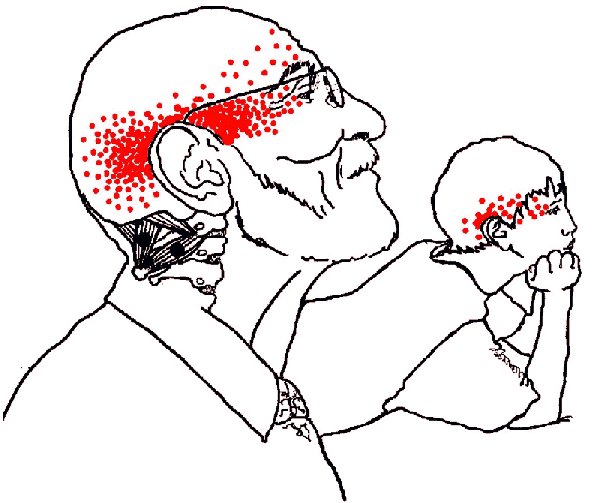 The four pairs of suboccipital muscles cause deep aching pain
running in a band from the back of the head to the orbit of the eye, possibly
with balance problems and dizziness.
One of these (the rectus capitis superior minor) attaches directly to the
dura mater of the spinal cord. When traumatized it can produce odd visual and
neurological symptoms to the point of seizures. The four pairs of suboccipital muscles cause deep aching pain
running in a band from the back of the head to the orbit of the eye, possibly
with balance problems and dizziness.
One of these (the rectus capitis superior minor) attaches directly to the
dura mater of the spinal cord. When traumatized it can produce odd visual and
neurological symptoms to the point of seizures.
Suboccipitals are commonly strained or hypertrophied in persons who wear
bifocals, children who watch TV lying with chin propped on hands, and anyone who
habitually holds the head in position with chin up and neck flexed backward.
- Omohyoid > Head, neck, shoulder, and back pain. This small
muscle (actually missing from many anatomy books)can cause disabling pain
and dysfunction. It's just one of the several muscles that attaches to the hyoid
bone. The other end attaches to the scapula at the back of the shoulder. Aside
from the severe pain in shoulder, neck, and jaw (which often appears after a
bout of coughing or vomiting) there may also be weakness and tingling down arm
and fingers and symptoms of thoracic outlet syndrome. Pain patterns may be
confused with that of the scalenes or levator scapula. An excellent article on
The Omohyoideus Syndrome is
available online.
- Soleus > Heel and calf pain, sacral pain and cheek (facial)
pain. One of the outstanding examples of long-distance pain referral from
muscles. This muscle of the calf sends pain to the calf and heel
(commonly known "jogger's heel") -- but there's more.
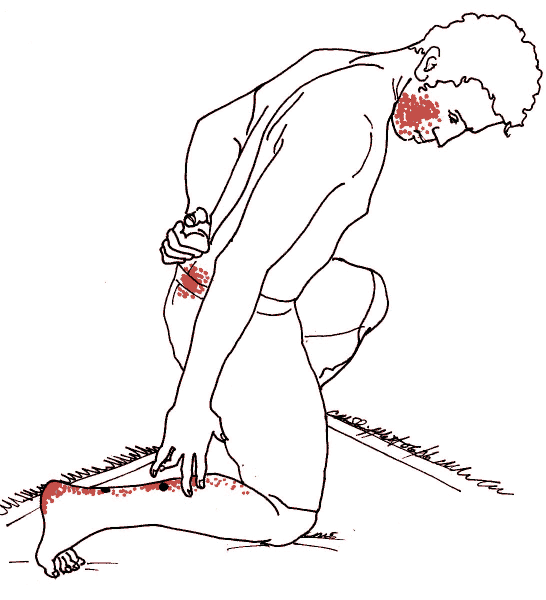 Pain from
this muscle also appears in the sacrum at the sacro-iliac joint and then
reappears in the face and jaw where it may fire off symptoms of TMJ and
toothache.
"But," you say, "migraine is vascular!" Pain from
this muscle also appears in the sacrum at the sacro-iliac joint and then
reappears in the face and jaw where it may fire off symptoms of TMJ and
toothache.
"But," you say, "migraine is vascular!"
Indeed it is -- and the soleus is the other end of the cardio-vascular
system. It is known as "The Second Heart" because its pumping action returns
blood from the lower extremities to the heart. I have stopped many full-blown
migraines by working adductor and calf muscles.
"But," you say, "migraine is neurological!"
Indeed it is -- and tightness and restriction in soleus and the adductor
magnus can cause serious impingement of neurovascular structures including the
femoral nerve, femoral artery, and femoral vein (at the adductor hiatus of the
adductor magnus) and the posterior tibial nerve, vein, and artery by the soleus.
(The plantaris, a slip of the soleus muscle, can also entrap the popliteal
artery at the back of the knee.) Entrapment by these muscles can be so severe
that the patient may lose deep tendon reflexes. Short of that, it's no surprise
that a sufferer might have cold feet.
Upstream, entrapment by the adductors can be brought on by failing to stretch
out after using the thigh machines at the gym and very commonly, by footwear. It
may be difficult to believe that shoes (whether you call them "cowboy boots" or
"high heels") may be causing your jaw and head pain, but it is often true.
Knee-high stockings with tight, constricting bands will do the job and I have
also seen a man who never had headaches in his life until he caught some
shrapnel in the calf. Even worse can happen, however.
When the soleus can no longer work as "the second heart" due to inactivity or
constriction, there can be side effects far worse than migraine. Pooling and
subsequent clotting of blood in the lower extremities is involved in deep vein
thrombosis, also known as "airline thrombosis" due to the consequences of a
cramped seat and long periods of inactivity. The condition is very real, but
sadly mis-named. The condition arises far more commonly from long hours of
sitting at a desk than from (relatively rare) airline travel.
|
|



3 comments:
I want to say that my grief is got to be of the last one mentioned...The SOLEUS MUSCLE...and let me tell u that I have pain in ALL of those areas and that it, is NOT fun. Just pray for me and maybe, "Lord Willing"..I will get this or whatever it is, better. ONLY if He wills it to be so.:))<3 Karen
Who believes this? http://www.google.com/search?q=2012
Well, anonymous...the muscles in our body are connected with the nerves and the vascular aspects of the body. Did u read it? It makes perfect sense to me because I live in muscle pain everyday.:))<3 K
Post a Comment